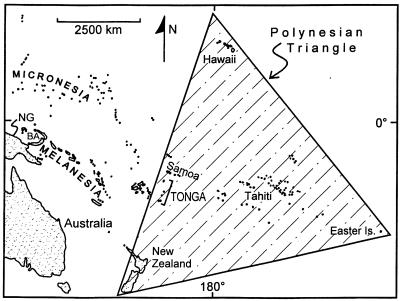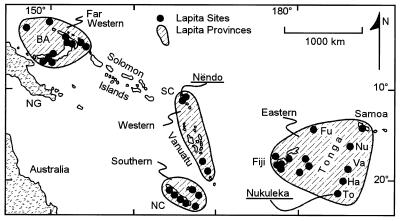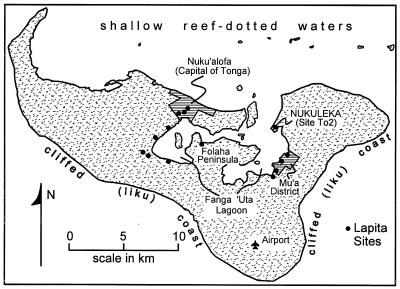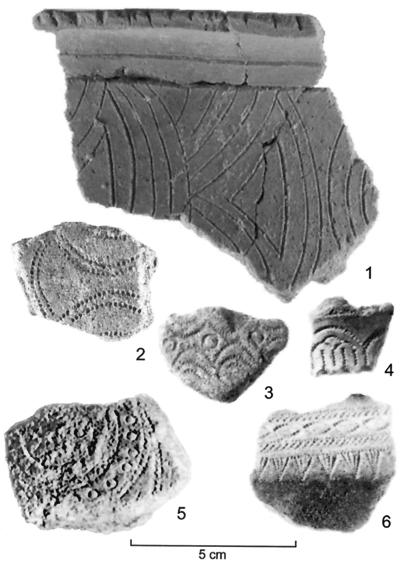Abstract
Selected prehistoric potsherds from the deepest cultural level of the oldest known archaeological site in the Kingdom of Tonga, within the Eastern Lapita province of western Polynesia, display decorative motifs characteristic of the Western Lapita province of modern-day Island Melanesia, to the west. Most of the stylistically anomalous sherds contain temper sands exotic to Tonga but, in one case, petrographically indistinguishable from temper in a Lapita sherd recovered from the Santa Cruz Islands of Melanesia, and are inferred to record maritime transport of Lapita ceramics into Tonga from Melanesia far to the west. The non-Tongan sherds found on Tongatapu provide direct physical evidence for interisland transfer of earthenware ceramics between Western and Eastern Lapita provinces, and the Nukuleka site, where they occur, is interpreted as one of the founding settlements of Polynesia.
Archaeologists have long debated the paths and timing of human settlement of Pacific Oceania, especially as it involved the ancestors of modern Polynesians (1). Evaluation of data from an archaeological site on Tongatapu in the Kingdom of Tonga documents one of the founding settlements of western Polynesia. Ceramic typology and petrographic temper analysis of Lapita potsherds recovered from the oldest cultural horizon at the site jointly indicate close association with comparable ceramic wares known from the Santa Cruz Islands of modern Melanesia to the west. The fragments of pottery exotic to Tonga are the first ceramic objects providing physical evidence for maritime linkage between eastern and western segments of the wide oceanic region settled near the beginning of the first millenium B.C.E. by Lapita peoples, culturally ancestral to modern Polynesians (2, 3).
The Kingdom of Tonga is an elongate South Pacific archipelago extending 750 km along the western edge of Polynesia (Fig. 1). Recent archaeological research in the Ha'apai Group of central Tonga (4) indicates initial colonization by people making Lapita ceramics between 850 B.C.E. and 800 B.C.E. (2,800–2,750 calendar years B.P.). Lapita pottery is a distinctively decorated, low-temperature-fired earthenware first made in the Bismarck Archipelago (ref. 1, p. 113, and refs. 5 and 6) off the northeast coast of New Guinea during the interval of 3,450–3,200 calendar years B.P. (1500–1250 B.C.E.). The areal distribution of Lapita potsherds (Fig. 2) forms a slightly diachronous marker horizon delineating the migratory dispersal of peoples speaking Oceanic Austronesian languages as they spread across Island Melanesia (lying east of New Guinea) into western Polynesia (2, 3). Lapita settlement sites occur on most principal islands of Tonga (7), with the largest concentration surrounding Fanga ‘Uta Lagoon (Fig. 3) on the largest island of Tongatapu (“sacred south”).
Figure 1.
Location of Tonga along western leg of “Polynesian Triangle.” BA, Bismarck Archipelago; NG, New Guinea.
Figure 2.
Distribution of Lapita sites (including Nëndo and Nukuleka) in southwest Pacific region (see Fig. 1 for location). BA, Bismarck Archipelago; NG, New Guinea; Fu, Futuna; Ha, Ha'apai; NC, New Caledonia; Nu, Niuatoputapu; SC, Santa Cruz Islands; To, Tongatapu; Va, Vava'u.
Figure 3.
Known Lapita sites surrounding Fanga ‘Uta Lagoon on Tongatapu (see Fig. 2 for location).
Data from archaeological tests done in 1999 at Nukuleka (site To2), strategically positioned at the entrance to Fanga ‘Uta Lagoon, when combined with results from a 1965 excavation (8), indicate that the lowest cultural horizon records the oldest settlement with Lapita ceramics yet discovered in Tonga (9). Radiocarbon ages for the Lapita stratum include a charcoal date of 2,790 ± 50 B.P. (CAMS 59624), calibrated to 900 ± 50 B.C.E., and a marine shell date (ANU 541) corrected to 2820 ± 90 B.P. (870 ± 90 B.C.E.) by using a lagoon-specific reservoir correction (10). These dates between 900 B.C.E. and 850 B.C.E. are slightly earlier than any undisputed dates for other Lapita sites on Fanga ‘Uta Lagoon or elsewhere in Tonga, where the later interval of 850–800 B.C.E. is the oldest dated with confidence (4, 7, 9).
The relative antiquity of the Nukuleka site is confirmed independently of isotopic dating by the nature of its ceramic assemblage. Lapita ceramics are broadly similar in vessel forms and decorative designs across the full span of Lapita occupation sites from the Bismarck Archipelago for 4,250 km eastward to Tonga and Samoa. Across that vast seascape of islands, however, regional variations in decorative motifs and the technology of their application define a spectrum or gradient of related ceramic types characteristic of different Lapita provinces and periods (2, 11–14). Several of the Nukuleka vessels display elaborate decorative styles (Fig. 4) characteristic of early Lapita ceramics from much farther to the west, within modern-day Island Melanesia, rather than those of typical Tongan Lapita wares. The presence of pottery having affinity with the Western Lapita province (Fig. 2), and its absence elsewhere in Tonga, suggests that Nukuleka was a founding colony where earlier pottery styles that had developed within the Western Lapita province persisted locally for a brief period within the Eastern Lapita province. Most of the Nukuleka sherd collection represents indigenous Tongan wares of Eastern Lapita aspect, suggesting that some or all of the unusually decorated sherds might be intrusive at the site.
Figure 4.
Representative sherds of Western Lapita aspect from the Eastern Lapita site at Nukuleka (see Fig. 3 for location).
A number of the western-style sherds have clay pastes of a light tan color, which is aberrant with respect to the dark reddish-brown pastes characteristic of indigenous Tongan sherds. Petrographic analysis (Table 1) of four of the tan sherds indicates non-Tongan origin by an absence of orthopyroxene and the presence of hornblende in pyroxene-rich placer sands, which were used as temper. Preliminary petrographic study (15) of the tan-paste sherds erroneously suggested a Tongan origin for the tempers from the pyroxene-rich character of the sands. Subsequent work (16, 17) has shown that Tongan placer sands and sherd tempers uniformly lack hornblende, but contain significant orthopyroxene (opx) as well as clinopyroxene (cpx). Pyroxene index (18), defined as cpx/(cpx + opx), lies in the range 0.82–0.89 for Tongan placer sands and sherd tempers of Ha’apai, Tongatapu, and Niuatoputapu (Fig. 2), rising to 0.89–0.95 for comparable materials from Vava'u (Fig. 2), but is consistently 1.0 (no opx at all) for the tempers in the tan-paste sherds.
Table 1.
Mineralogical compositions of sand tempers in tan-paste sherds from Nukuleka and Nëndo
| Grain type | Nukuleka (To2537) n = 545 | Nukuleka (To3750) n = 555 | Nukuleka (To2070) n = 440 | Nukuleka (99–10) n = 400 | Nëndo (SZ8-68/12) n = 400 |
|---|---|---|---|---|---|
| Quartz | 1 | 1 | 3 ± 1 | 19 ± 2 | 19 ± 2 |
| Plagioclase | 8 ± 1 | 14 ± 1 | 22 ± 2 | 12 ± 2 | 14 ± 2 |
| Clinopyroxene | 76 ± 2 | 74 ± 2 | 62 ± 2 | 58 ± 3 | 52 ± 3 |
| Hornblende | 2 ± 1 | trace | trace | 1 | 2 ± 1 |
| Opaques | 9 ± 1 | 5 ± 1 | 9 ± 1 | 4 ± 1 | 6 ± 1 |
| VRF | 4 ± 1 | 6 ± 1 | 4 ± 1 | 6 ± 1 | 7 ± 1 |
Individual sherd labels are in parentheses. Figures are grain frequency percentages based on counts of n grains in thin section. Opaques are opaque iron oxides, mainly magnetite. VRF denotes polycrystalline and polyminerallic volcanic rock fragments. Standard deviation (±) of counting error given by [p(100 − p)/n]1/2 where p is percentage. See Fig. 2 for locations.
We conclude that the tan-paste sherds were brought to Tongatapu from outside Tonga during the earliest phase of Lapita occupation at Nukuleka. The presence at Nukuleka of a few sherds with western-style decorative motifs but indigenous Tongan temper sands and reddish pastes implies that the ingrained ceramic tradition of the initial settlers persisted among some potters for some indeterminate interval of time after Lapita occupation of Tongatapu. Most indigenous wares at Nukuleka display eastern-style decorative motifs typical of other Tongan Lapita wares, implying that the local persistence of western-style decorative motifs was a transient cultural trait.
The temper sand in one of the tan-paste Nukuleka sherds (no. 99-10) is further notable for its comparatively high quartz content, and mineralogical composition and textural properties that are statistically indistinguishable from the temper sand in a sherd excavated from a Lapita site on Nëndo (Fig. 2) in the Santa Cruz Islands of Melanesia (Table 1). No other temper sands in ≈1,200 prehistoric sherds from ≈100 sites or site clusters on ≈50 islands or island clusters within any of the various Lapita provinces (Fig. 2) bear any close compositional resemblance to the temper in the Nukuleka/Nëndo sherd pair (19–21). In particular, the joint dominance of quartz and pyroxene is unique.
The quartzose temper sand differs from the well known quartz-free temper sands present in indigenous Nëndo sherds derived from locally exposed andesitic to basaltic source rocks (21), but is also a volcanic sand, and may record ceramic transfer to Nëndo from some nearby island in the Western Lapita province of central Island Melanesia, where quartz-bearing sand derived from dacitic source rocks is expected to be present locally. The source island of the temper remains unknown, but the Lapita occupants of Nukuleka and Nëndo were evidently either in mutual contact with it, or else wares from it were relayed through Nëndo to Nukuleka. Less quartzose tempers in other tan-paste sherds from Nukuleka are probably variants of a temper–sand spectrum that includes the quartzose temper (Table 1).
Our observations for the Nukuleka site have two important implications for Oceanian prehistory. First, as a founding settlement, Nukuleka probably served as the initial staging point for population expansion within western Polynesia from Tongatapu northward to other parts of Tonga and into Samoa. Second, the presence of ceramic objects at Nukuleka revealing physical ties back to the Santa Cruz Islands may imply that Tonga was initially settled by voyagers traveling directly from central Island Melanesia, rather than through intermediate settlements in Fiji (Fig. 2) as has commonly been assumed. Alternately, the quartzose temper common to anomalous sherds from Nukuleka and Nëndo may conceivably derive from some as yet untested locale within Fiji from which Lapita wares were dispersed both eastward and westward. The latter interpretation is disfavored, however, because no Lapita sherds of comparable western-style aspect are known from extensive investigations on multiple islands in Fiji (21). In either case, the presence of petrographically indistinguishable temper sands in Nukuleka and Nëndo sherds documents geographically extensive interisland voyaging from or through island groups lying well to the west of Tonga during the earliest human presence in Polynesia.
Acknowledgments
We thank Jens Poulsen for first calling attention to the uniqueness of the tan-paste sherds at Nukuleka, R. C. Green for providing the comparable sherd from Nëndo, and the government of King Taufa'ahau Tupou IV for permission to conduct research in Tonga. Jim Abbott of SciGraphics (Tucson, AZ) prepared the figures. Research was supported in part by the Social Sciences and Humanities Research Council of Canada.
References
- 1.Kirch P V. On the Road of the Winds: An Archaeological History of the Pacific Islands Before European Contact. Berkeley: Univ. California Press; 2000. [Google Scholar]
- 2.Kirch P V. The Lapita Peoples: Ancestors of the Oceanic World. Cambridge, MA: Blackwell; 1997. [Google Scholar]
- 3.Spriggs M. The Island Melanesians. Cambridge, MA: Blackwell; 1997. [Google Scholar]
- 4.Burley D V, Nelson D E, Shutler R., Jr Archaeol Oceania. 1999;34:59–70. [Google Scholar]
- 5.Specht J, Gosden C. Asian Perspectives. 1997;36:175–199. [Google Scholar]
- 6.Kirch P V. In: Lapita and its Transformations In Near Oceania. Kirch P V, editor. Berkeley: Univ. California Press; 2001. Univ. California Archaeol. Res. Facility Contribution 59, pp. 196–236. [Google Scholar]
- 7.Burley D V. J World Prehist. 1998;12:337–392. [Google Scholar]
- 8.Poulsen J. Early Tongan Prehistory: The Lapita Period on Tongatapu and its Relationships. Canberra, A.C.T., Australia: Australia Natl. Univ.; 1987. , Terra Australis 12. [Google Scholar]
- 9.Burley D V, Dickinson W R, Barton A, Shutler R., Jr Archaeol Oceania. 2001;36:88–103. [Google Scholar]
- 10.Spenneman D H R, Head M J. Quat Geochron. 1997;17:1047–1056. [Google Scholar]
- 11.Green R C. In: The Prehistory of Polynesia. Jennings J D, editor. Cambridge, MA: Harvard Univ. Press; 1979. pp. 27–60. [Google Scholar]
- 12.Anson D. Archaeol Oceania. 1986;22:157–156. [Google Scholar]
- 13.Spriggs M, editor. Lapita Design, Form and Composition. Canberra, A.C.T., Australia: Australia Univ. Press; 1990. Australia Natl. Univ. Occasional Papers Prehist. 19. [Google Scholar]
- 14.Sand C. Archaeol Oceania. 2000;35:20–33. [Google Scholar]
- 15.Dickinson W R. In: Early Tongan Prehistory: The Lapita Period on Tongatapu and Its Relationships. Poulsen J, editor. Canberra, A.C.T., Australia: Australia Natl. Univ.; 1987. , Terra Australis 12, 278. [Google Scholar]
- 16.Dye T S, Dickinson W R. Geoarchaeology. 1996;11:141–164. [Google Scholar]
- 17.Dickinson W R, Shutler R, Jr, Shortland R, Burley D V, Dye T S. Archaeol Oceania. 1996;31:87–98. [Google Scholar]
- 18.Dickinson W R. Rec Austral Mus. 1998;50:263–276. [Google Scholar]
- 19.Dickinson W R. N Z J Archaeol. 1998;20:161–182. [Google Scholar]
- 20.Dickinson W R, Shutler R., Jr J World Prehist. 2000;14:203–266. [Google Scholar]
- 21.Dickinson W R. Geoarchaeology. 2001;16:275–322. [Google Scholar]






